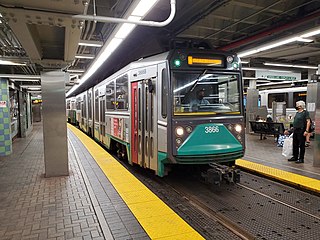
Back Green Line (MBTA) Catalan Green Line (MBTA) German Línea Verde (Metro de Boston) Spanish Ligne verte du métro de Boston French Linea verde (metropolitana di Boston) Italian 그린 라인 (MBTA) Korean Green Line (Boston) Dutch Linha Verde (Metro de Boston) Portuguese Зелёная линия (MBTA) Russian สายสีเขียว (องค์การขนส่งอ่าวแมสซาชูเซตส์) Thai
The Green Line is a semi-metro system[4][5] (form of light rail) run by the Massachusetts Bay Transportation Authority (MBTA) in the Boston, Massachusetts, metropolitan area. It is the oldest MBTA subway line, and with tunnel sections dating from 1897, the oldest subway in North America.[6] It runs underground through downtown Boston, and on the surface into inner suburbs via six branches on radial boulevards and grade-separated alignments. With an average daily weekday ridership of 137,700 in 2019, it is the third-most heavily used light rail system in the country.[1] The line was assigned the green color in 1967 during a systemwide rebranding because several branches pass through sections of the Emerald Necklace of Boston.[7][8][9]
The four branches are the remnants of a large streetcar system, which began in 1856 with the Cambridge Horse Railroad and was consolidated into the Boston Elevated Railway several decades later. The branches all travel downtown through the Tremont Street subway, the oldest subway tunnel in North America. The Tremont Street subway opened its first section on September 1, 1897, to take streetcars off overcrowded downtown streets; it was extended five times over the next five decades. The streetcar system peaked in size around 1930 and was gradually replaced with trackless trolleys and buses, with cuts as late as 1985. The new D branch opened on a converted commuter rail line in 1959. The Green Line Extension project extended two branches into Somerville and Medford in 2022.
- ^ a b "Transit Ridership Report: Fourth Quarter 2019" (PDF). American Public Transportation Association. February 27, 2020.
- ^ Cite error: The named reference
bluebookwas invoked but never defined (see the help page). - ^ Booz • Allen & Hamilton Inc. (1995). "Applicability of Low-Floor Light Rail Vehicles in North America" (PDF). Transit Cooperative Research Program. Retrieved August 7, 2013.
- ^ Ian Yearsley (December 21, 1972). "Trams are coming back". New Scientist. Reed Business Information Ltd. Archived from the original on January 17, 2023. Retrieved August 28, 2023.
... San Francisco and Boston, both with semi-metros and independent plans for new tramcars.
- ^ De Leuw, Cather & Company (1976). Light Rail Transit: A State of the Art Review. p. 9. Retrieved August 28, 2023.
- ^ Most, Doug (January 26, 2014). "The bigger dig". Boston Globe. Retrieved January 22, 2016.
- ^ Cite error: The named reference
netransitwas invoked but never defined (see the help page). - ^ Sanborn, George M. (1992). A Chronicle of the Boston Transit System. Massachusetts Bay Transportation Authority. Archived from the original on November 27, 2019. Retrieved January 21, 2016 – via MIT.
- ^ "Curiosity Carcards" (PDF). Massachusetts Bay Transportation Authority. Archived from the original (PDF) on February 18, 2017. Retrieved January 21, 2016.
© MMXXIII Rich X Search. We shall prevail. All rights reserved. Rich X Search
